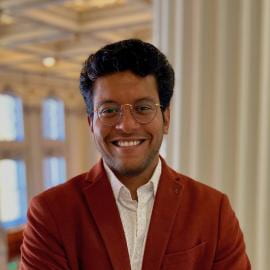
Faculty Highlight
Meet the Expert:
Gaurav Doshi
By Poornima Apte
The assistant professor in applied economics researches, among other topics, ways to make the benefits of large electrification projects more transparent.

It’s a chicken and egg situation: Should renewable energy projects launch first hoping that transmission lines to pipe generated power to distant places will follow on their heels? Or should the transmission lines be stood up first as a way to attract investments in renewable energy projects? Which comes before the other? It’s a question that has intrigued Gaurav Doshi, assistant professor at the School of Economics at Georgia Tech, for a while now. His award-winning paper about this research explores the downstream effects of building power lines.
After a bachelor’s and master’s degree in applied economics from the Indian Institute of Technology at Kanpur, Doshi earned his doctorate in the same field from the University of Wisconsin at Madison in 2023. He explored questions about environmental economics as part of his doctoral work.
“Once I started researching energy markets in the U.S., I kept getting deeper and coming up with new questions,” Doshi says. Among the many his work explores: What are the effects of infrastructure policies and how can they help decarbonization efforts? What are some of the unintended consequences policy makers need to think about?
One of his current research projects has roots in his doctoral work. It explores how to quantify the benefits of difficult-to-quantify environmental infrastructure projects. Case in point: Decarbonization will likely lead to more electrification from renewable energy resources and will need power lines to transport this energy to places of demand. The costs for such infrastructure are pretty transparent as part of government project funding. But the benefits are less so, Doshi points out. To develop effective policy, both the costs and benefits need clear visibility. “Otherwise the question arises ‘why should we spend billions of dollars of taxpayer money if we don’t know the benefits?’”
The research has evaluated a use case in Texas where the $7 billion massive CREZ Transmission project connects wind farms in west Texas to major metropolitan centers. The results of the investment have been largely positive. One of the findings of the research: More wind-based electricity in the grid led to billions of dollars worth of lower carbon emissions. The lines have also provided project developers market access to sell electricity. “It’s like building roads, it opens up paths to develop business,” Doshi says. The other benefit that researchers have found is that farmers are excited to lease a part of the land they own to wind developers. “For them also this is sort of a side additive income apart from their farming business,” Doshi says, “they get good rates from wind developers and together might see millions of dollars in aggregate
income.” In addition, benefits like cleaner air, accrue for everyone, and have to be taken into account, as do others that build up over time.
Policy makers can use results from such research to get a more clear picture of the landscape and make data-driven informed decisions. Uncertainty about issues like tariffs can also be accounted for.
Exploring the effects of the 2022 Inflation Reduction Act (IRA) forms another project Doshi is working on in conjunction with a researcher from New Mexico State University and from the College of Wooster. One of the many benefits the act introduced was the concept of place-based incentives, where a renewable energy developer would receive tax bonuses to invest in specific underserved regions of the country. “The broad idea is to incentivize renewable development in economically disadvantaged locations that have historically relied on fossil fuel production [for jobs],” Doshi says. Coal country is an example. Doshi’s related research is two-pronged: to evaluate if place-based initiatives work at all. And to gauge how much of an incentive is needed, especially in areas that are resource-poor.
Doshi complements his research with teaching classes, including a course in machine learning for economics. While both computer scientists and economists might share an interest in data, economists are more interested in isolating causal effects. “While we typically don’t need computer vision or image recognition algorithms, we have data on labor and market choices that can benefit from machine learning methods in our causal inference analyses,” Doshi says. He was a teaching assistant for a similar course in Madison and has developed and refined the material at Georgia Tech. Students from a variety of disciplines including computer science, biomedical engineering, and economics take the class. “It’s fun to have these conversations with students who come at the material from different perspectives,” Doshi says.
Over the near and long term, Doshi is looking forward to being steeped in energy and environmental economics research, issues that have galvanized him for years.